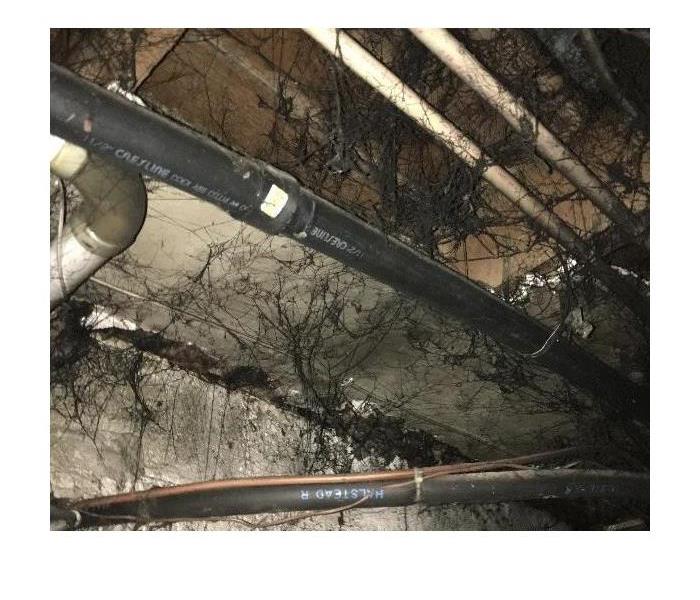Furnace and Boiler Puffbacks in Macomb County
1/8/2018 (Permalink)
The following article on “Furnace and Boiler Puffbacks”, written by Matt Livingston of HVAC Investigators, originally appeared in the Technical Notebook Column of Claims Magazine and was also published on Property Casualty 360.
As the weather gets colder and homeowners start up their heating systems for the first time in months, insurance carriers see an influx of claims for the failure of furnaces and boilers. One frequent issue that can be both messy and potentially dangerous is a phenomenon known as a “puffback.”
A puffback is a release of smoke or soot that occurs when a boiler or furnace misfires. It is important that adjusters and insurance carriers understand what a puffback is and what causes one to occur. Not only are they expensive (and occasionally dangerous), but they are often caused by a non-covered cause of loss.
What is a puffback?
A puffback occurs when a furnace or boiler does not ignite properly and allows oil or gas vapors to build up within the ignition/combustion chamber. When it does finally ignite, the excess fuel in the chamber causes this puffback scenario. The result can be anywhere from a small amount of smoke to a minor explosion, depending on how much fuel has accumulated in the chamber.
Puffbacks can occur in both oil and gas furnaces and boilers, but are much more common in oil-fired equipment. Oil furnaces and boilers require more maintenance than their gas-fired counterparts, presenting more opportunities for the ignition process to be hindered if the system is not properly maintained. Additionally, oil is less likely than gas to dissipate, leading to larger average explosions. Forced air, oil-fired heating system puffbacks tend to be the messiest, as oil creates more soot than gas, and the ductwork for the forced air system can spread that soot to every room in the home.
What causes a puffback?
Regardless of fuel type, furnaces and boilers should have annual system maintenance. Puffbacks generally occur due to a lack of this routine maintenance or because of age-related wear and tear. Specific causes can include:
- A leak at or near the combustion chamber can allow the fuel to build up in the combustion chamber and can cause a puffback to occur upon ignition.
- A clogged exhaust or chimney that is obstructed by dirt, dust, fuel residue, rust or corrosion could prevent combustion gases from properly venting out of the furnace. This can cause an internal pressure irregularity that can eventually lead to a puffback, due to an incorrect ratio of fuel to air.
- A cracked heat exchanger (similar to a clogged exhaust or chimney) prevents the combustion gases from properly venting out the furnace and results in an internal pressure irregularity that can cause a flame roll out. The resulting improper combustion process allows excess fuel to enter the ignition chamber and potentially lead to a puffback when ignition occurs.
- Manually resetting the system too often when it fails to ignite may cause unburned fuel to accumulate in the chamber and can lead to a puffback once ignition finally occurs.
- A damaged oil fuel nozzle, such as one that is clogged or cracked, may cause the oil to spray unevenly and result in insufficient fuel for the burners to ignite. The nozzle will continue to attempt to spray and allow excess oil to enter the burner over time. When the oil eventually ignites, a puffback can occur.
- A clogged burner full of dirt, dust, fuel residue, rust or corrosion can cause a misfire and allow excess fuel to build up in the combustion chamber. This may eventually lead to a puffback when the fuel at last ignites.
How do you diagnose the cause of a puffback?
Following a puffback event, it is often not recommended to turn the system on and perform full diagnostic testing, as this can be both dangerous and messy. There are, however, other ways for HVAC professionals to detect if a puffback has occurred and what the chief contributor to the problem might have been. These diagnostic steps include:
- Check for fuel leaks in and around the combustion chamber. Visible signs of leaking oil are a strong sign that a puffback has occurred, and that the leak and/or air in the oil line were the primary culprits.
- Check the exhaust/flue for clogs. Blockage in the heating system exhaust could impact the fuel-to-air ratio and prevent fumes from safely venting. If observed during the post-puffback investigation, this blockage is a likely contributor to the problem.
- Perform a “candle check” of the heat exchanger. Holding a lit flame near the heat exchanger while the blower is on will provide a visual indication that a crack is present, and will thus provide a likely puffback cause.
- Inspect the oil nozzle and burner assembly for damage, checking to see if this condition caused the puffback. However, depending on the severity of the puffback incident, the fuel nozzle and burners themselves may have been damaged, limiting the ability to definitively diagnose the puffback cause using this method.
You should also follow up with a mitigation company that can test throughout your house to verify the extent of the damage and if an insurance claim needs to be filed. You can set up your free appointment with our professionals today at SERVPRO of St. Clair Shores at (586) 741-5050.






 24/7 Emergency Service
24/7 Emergency Service
